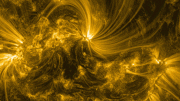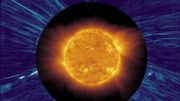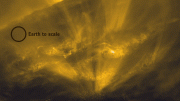This video compares the two models for particle distribution over the course of just three hours after a SEP event. The white line represents a magnetic field line, the general path that the SEPs follow. The line starts at a SEP event at the sun, and leads the particles in a spiral around the sun. The animation of the updated model, on the right, depicts a static field line, but as the SEPs travel farther in space, turbulent solar material causes wandering field lines. In turn, wandering field lines cause the particles to spread much more efficiently than the traditional model, on the left, predicted.
New research challenges solar radiation models, showing how particles could travel to the back of the sun no matter what type of event first propelled them.
In addition to the constant emission of warmth and light, our sun sends out occasional bursts of solar radiation that propel high-energy particles toward Earth. These solar energetic particles, or SEPs, can impact astronauts or satellites. To fully understand these particles, scientists must look to their source: the bursts of solar radiation.
But scientists aren’t exactly sure which of the two main features of solar eruptions –narrow solar flares or wide coronal mass ejections – causes the SEPs during different bursts. Scientists try to distinguish between the two possibilities by using observations, and computer models based on those observations, to map out where the particles could be found as they spread out and traveled away from the sun. NASA missions STEREO and SOHO collect the data upon which these models are built. Sometimes, these solar observatories saw SEPs on the opposite side of the sun than where the eruption took place. What kind of explosion on the sun could send the particles so far they ended up behind where they started?
Now a new model has been developed by an international team of scientists, led by the University of Central Lancashire and funded in part by NASA. The new model shows how particles could travel to the back of the sun no matter what type of event first propelled them. Previous models assumed the particles mainly follow the average of magnetic field lines in space on their way from the sun to Earth, and slowly spread across the average over time. The average field line forms a steady path following a distinct spiral because of the sun’s rotation. But the new model takes into consideration that magnetic field lines can wander – a result of turbulence in solar material as it travels away from the sun.
With this added information, models now show SEPs spiraling out much wider and farther than previous models predicted – explaining how SEPs find their way to even the far side of the sun. Understanding the nature of SEP distribution helps scientists as they continue to map out the origins of these high-energy particles. A paper published in Astronomy and Astrophysics summarizes the research, a result of collaboration between the University of Central Lancashire, Université Libre de Bruxelles, University of Waikato, and Stanford University.
Reference: “Solar energetic particle access to distant longitudes through turbulent field-line meandering” by T. Laitinen, A. Kopp, F. Effenberger, S. Dalla and M. S. Marsh, 6 June 2016, Astronomy & Astrophysics.
DOI: 10.1051/0004-6361/201527801








Be the first to comment on "New Research Challenges Solar Radiation Models"